The Golden Triangle, one of Northern India’s most iconic tourist circuits, often evokes mixed opinions. While concerns about overtourism and recommendations to explore lesser-known regions persist, the allure of legendary sites like the Taj Mahal remains irresistible. Setting out on a week-long journey through the Golden Triangle can evoke both excitement and apprehension, with expectations of tourist crowds balanced by hopes for memorable experiences.
Contrary to the anticipated challenges, the experience of visiting Delhi, Agra, and Jaipur can far exceed expectations. Rather than feeling overwhelmed, travelers often find themselves captivated by the vibrant cities, their architectural marvels, and cultural richness. Each moment spent in these historic destinations offers a deeper appreciation of India’s heritage and diversity.
This comprehensive guide delves into why the Golden Triangle remains such a cherished destination and provides practical insights to ensure an equally remarkable journey. From awe-inspiring monuments to immersive cultural encounters, the Golden Triangle promises unforgettable experiences. With helpful tips and recommendations, including guidance on choosing the best Golden Triangle Tour Packages, this guide serves as a resource for those seeking to explore one of India’s most captivating regions.
Where is the Golden Triangle located in India?

The Golden Triangle is situated in Northern India, forming a nearly perfect equilateral triangle on the map. This renowned travel route connects three of India’s most iconic cities: New Delhi, Agra, and Jaipur. New Delhi sits at the top of the triangle, Agra at the bottom-right, and Jaipur at the bottom-left. The distances between them are approximately 233 km from New Delhi to Agra, 237 km from Agra to Jaipur, and 273 km from Jaipur back to New Delhi, creating a well-connected and manageable circuit for travelers.
Most visitors begin their journey by flying into New Delhi, then proceed to Agra and Jaipur, although the route can be customized in any direction based on personal preferences. With a variety of transportation options—whether by road, rail, or air—each destination is easily accessible, making it an ideal itinerary for those looking to explore the region’s cultural richness and historical landmarks.
After completing the Golden Triangle, travelers can either return to New Delhi for departure or extend their trip to other captivating destinations in India. Popular next stops include Rajasthan, Mumbai, Varanasi, and Goa, offering even more diverse experiences for first-time visitors.
Overall, the Golden Triangle is a highly accessible and efficient way to experience the rich heritage and architectural wonders of three of India’s most fascinating cities, making it a must-see travel route for both first-time and seasoned explorers.
Why spend time in India’s Golden Triangle?

The Golden Triangle is one of India’s most popular travel routes, and for good reason. It’s the perfect way to dive into this incredible country’s rich history, culture, and beauty. Here’s why a journey through this iconic region is truly worth it:
Breathtaking Monuments: While the Taj Mahal is undeniably the star attraction, the Golden Triangle is filled with architectural wonders that are just as captivating. In Delhi, you’ll find the majestic Jama Masjid, the serene Humayun’s Tomb, the peaceful Lodhi Gardens, and the towering Qutub Minar. Agra isn’t just about the Taj—Agra Fort and the Itimad Ud Daulah Tomb are equally stunning. The royal Hawa Mahal, the impressive Amber Fort, and the astronomical marvel of Jantar Mantar are must-sees in Jaipur. Each city in the Golden Triangle reveals a new layer of India’s rich architectural heritage.
Three Unique Regions: Traveling through the Golden Triangle means exploring three very different parts of India. Jaipur introduces you to the beauty of the desert and the colorful culture of Rajasthan. Agra, nestled in Uttar Pradesh, is a city of grand monuments and deep spiritual significance. And then there’s Delhi, a city where ancient history meets modern chaos, offering a blend of experiences you won’t find anywhere else. This journey gives you a taste of India’s incredible diversity, all within a few days.
Cultural Immersion: The Golden Triangle isn’t just about the sights—it’s about experiencing India’s vibrant culture up close. From the bustling markets of Old Delhi to the lively streets of Jaipur, there’s something to captivate every sense. The rich aromas of local street food, the vibrant colors of traditional textiles, and the rhythmic chaos of daily life all come together to create an unforgettable atmosphere. This is India in all its lively, enchanting glory.
Travel Made Easy: The Golden Triangle is one of the most accessible travel routes in India, with great tourist infrastructure. Whether you’re staying in budget hostels or luxury hotels, or traveling by train or car, it’s easy to get around and explore. English is widely spoken, and modern conveniences like ride-sharing apps and online ticket booking make it easier than ever to navigate.
Something for Every Budget: One of the best things about traveling through the Golden Triangle is that it caters to every kind of traveler. From affordable guesthouses and street food stalls to five-star hotels and gourmet dining, there’s something for every budget. Whether you’re backpacking or indulging in luxury, you can have an incredible experience without breaking the bank.
In short, the Golden Triangle offers an unbeatable blend of historic landmarks, cultural richness, and modern convenience. It’s a perfect introduction to the wonders of India and an experience that will stay with you long after your journey ends.
How Much Time Is Needed to Explore the Golden Triangle?
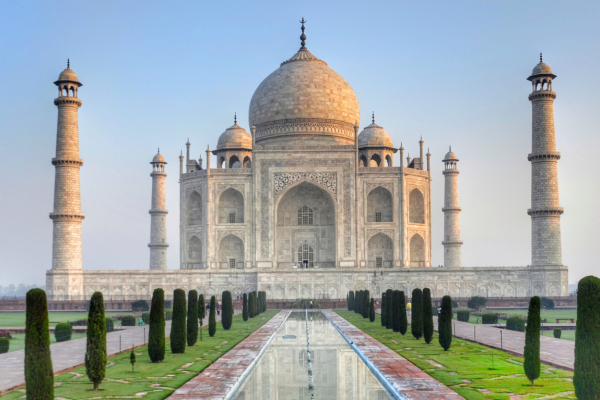
The ideal timeframe for exploring India’s Golden Triangle generally ranges between three to seven days, with many considering a week as the perfect minimum for a well-rounded experience. A seven-night, eight-day journey is often regarded as the optimal duration, allowing for a deeper dive into the region’s rich cultural and historical landmarks.
A common itinerary features four nights in New Delhi, one night in Agra, and two nights in Jaipur. However, itineraries can be tailored based on personal preferences. Some travelers may prefer to extend their stay in a particular city—such as Agra, for a more leisurely exploration of the Taj Mahal and other iconic sites. Nonetheless, a full seven days strikes an excellent balance, ensuring enough time to appreciate the major attractions without feeling rushed.
Ultimately, the length of a Golden Triangle tour can be customized to suit individual interests and schedules. Whether it’s a fast-paced trip or a more relaxed journey, having ample time to explore the highlights, immerse in local culture, and absorb the rich heritage of each city ensures a fulfilling experience.
Best Ways to Travel Around the Golden Triangle
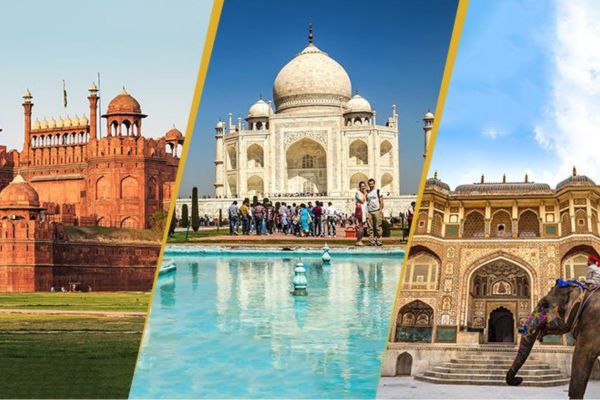
Train: Trains like the Gatimaan Express provide a fast and comfortable journey between New Delhi and Agra, with the trip taking around two hours. Tickets can be booked in advance through platforms like the IRCTC Website.
Private Driver: Hiring a driver is ideal for the route between Agra and Jaipur, allowing for stops at sites like Fatehpur Sikri. Most hotels can arrange a driver, and it’s advisable to plan for an eight-hour journey.
Tour Guide: Enhance your experience by hiring a guide, available through many Golden Triangle Tour Packages and Delhi Agra Jaipur Tour Packages, to gain deeper insights into each destination.
Combining these options ensures a smooth, enriching exploration of this famous region.
Best Time to Visit the Golden Triangle
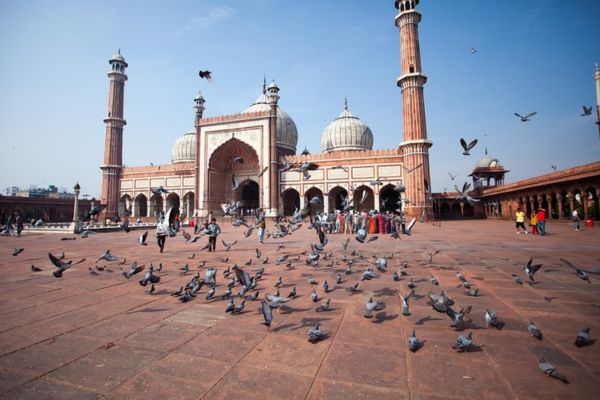
Choosing the ideal time to visit the Golden Triangle involves weighing several factors, as each season offers distinct advantages and challenges. Here’s an overview of what to expect during different times of the year:
One of the most favorable periods to visit is during the winter months, particularly from November to February. At this time, daytime temperatures hover around a comfortable 23°C (73°F), dropping to a cooler 15°C (60°F) at night. These mild conditions make exploring the attractions in Delhi, Agra, and Jaipur more enjoyable, without the discomfort of intense heat.
However, a drawback of visiting during winter is the prevalence of smog in Northern India. Factors such as crop burning, vehicle emissions, and construction dust contribute to heavy pollution, which can reduce visibility and affect air quality. For those sensitive to air conditions, it’s important to take precautions, especially during this period.
Additionally, winter mornings are often accompanied by dense fog, which can obscure views of iconic landmarks like the Taj Mahal at sunrise. To counter this, many visitors opt for a sunset visit, where the visibility is generally clearer, and the monument is bathed in the warm glow of the setting sun.
Ultimately, deciding the best time to visit the Golden Triangle depends on individual preferences, whether it’s avoiding the scorching summer heat or seeking fewer crowds. Factors like weather, air quality, and specific experiences should guide the planning for an unforgettable journey through this remarkable region.
Why Booking a Guided Tour is the Best Way to Explore India’s Golden Triangle
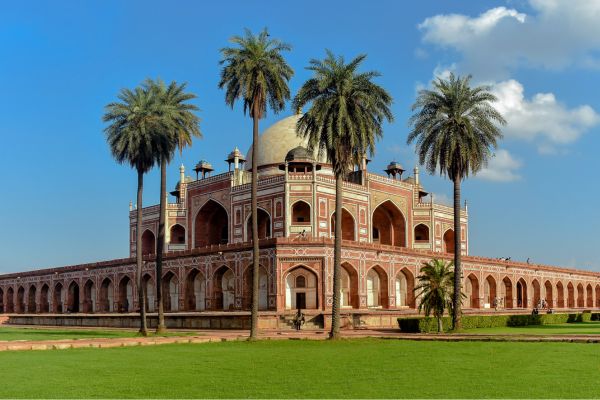
When planning a trip to India’s Golden Triangle, one question often arises is whether to take a guided tour or explore independently. The Golden Triangle isn’t just a historical route—it’s a vibrant region brimming with family-friendly activities and rich cultural experiences that cater to all ages. From wandering through the majestic forts of Jaipur to tasting the authentic street food of Delhi, the diversity of experiences is bound to leave lasting memories.
Choosing a trusted tour operator, like SRM Holidays, can elevate your journey, ensuring a seamless and hassle-free experience. SRM Holidays has earned the prestigious Traveler’s Choice award for 2023 on Tripadvisor, a testament to the quality and reliability of their service. As a leading travel agency in Delhi, SRM Holidays offers a variety of packages that make exploring the Golden Triangle not only convenient but also enriching.
Opting for a tour through SRM Holidays allows you to focus on the excitement of discovery without worrying about logistics. Their Golden Triangle Tour Packages are designed to provide an immersive experience, highlighting the cultural heritage of Delhi, Agra, and Jaipur. For those with limited time, SRM Holidays offers tailored options like the Delhi Agra Tour Packages, Same Day Agra Tour by Car, Same Day Agra Tour from Delhi, and One Day Agra Tour from Delhi, each offering a chance to marvel at the Taj Mahal and other iconic landmarks. For those focused on a specific experience, the Taj Mahal Tour from Delhi delivers a perfect opportunity to explore one of the world’s most famous wonders.
By booking through a trusted travel agency, travelers can rest assured that every detail is handled professionally, allowing them to fully immerse themselves in the journey. From expertly guided tours to well-planned itineraries, SRM Holidays ensures that your adventure through India’s most iconic cities is filled with unforgettable moments. So gather your family, pack your bags, and embark on an adventure through the Golden Triangle that will be cherished for a lifetime.
How to Spend Your Time on This Iconic Journey
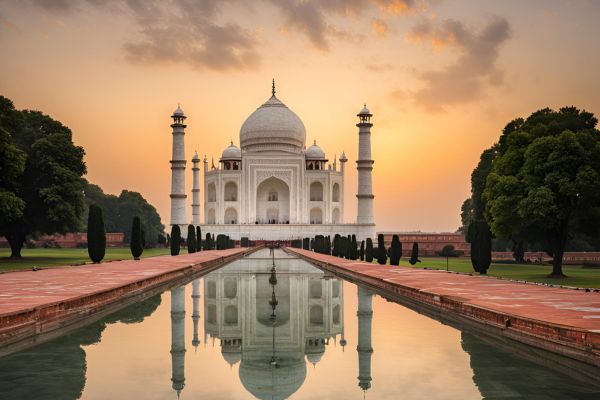
Exploring India’s Golden Triangle offers a perfect mix of history, culture, and architectural grandeur. In this 7-day itinerary, you can experience the highlights of Delhi, Agra, and Jaipur seamlessly. Here’s a day-by-day breakdown of how to make the most of your time in this iconic region:
Day 1: Arrival in Delhi
The adventure begins in Delhi, the vibrant capital of India. Upon arrival, you’ll be warmly greeted and transferred to your hotel. The first day is reserved for relaxation, allowing you to settle in and prepare for your exploration ahead. Take a leisurely walk around local markets or unwind at your hotel.
Day 2: Explore Delhi’s Historical Landmarks
Day 2 offers a full-day exploration of Delhi, featuring iconic sites like Red Fort, India Gate, and Rashtrapati Bhawan. Discover the grand Qutub Minar, a UNESCO World Heritage site, and visit the serene Lotus Temple. End your day with a stroll through Connaught Place, where you can indulge in shopping or sample local delicacies.
Day 3: Delhi to Agra
On the third day, travel from Delhi to Agra, famous for the world-renowned Taj Mahal. Begin your day with a visit to this architectural wonder and later explore Agra Fort, another UNESCO site with its grand Mughal architecture. Conclude with a visit to the Tomb of Itmad-ud-Daulah, often called the “Baby Taj” for its intricate beauty. If short on time, consider SRM Holidays’ Same Day Agra Tour by Car or One Day Agra Tour from Delhi to experience these highlights in a day.
Day 4: Agra to Jaipur (via Fatehpur Sikri)
Depart Agra for Jaipur, but not before visiting the fascinating Fatehpur Sikri, a UNESCO World Heritage site and former Mughal capital. This ghost city is rich with beautiful palaces and mosques, offering a glimpse into the grandeur of the past. Continue your journey to Jaipur, also known as the Pink City, and check in at your hotel.
Day 5: Explore Jaipur’s Majestic Sights
Start Day 5 with a visit to Amber Fort, where you can take an elephant ride or jeep up the hill to this majestic fort. Next, visit City Palace, the residence of Jaipur’s royal family, and explore Jantar Mantar, the world’s largest stone sundial. Don’t miss the stunning Hawa Mahal, also known as the Palace of Winds. This day will immerse you in Jaipur’s royal heritage.
Day 6: Leisure and Local Exploration in Jaipur
Day 6 is reserved for personal exploration or relaxation in Jaipur. Spend the day at your own pace, whether that’s visiting more of the city’s cultural landmarks or diving into the local markets for authentic Rajasthani crafts, jewelry, and textiles. This is the perfect opportunity to soak in the vibrant atmosphere of Jaipur, sample traditional Rajasthani cuisine, or simply relax and reflect on your journey so far. If you’re in the mood for more sightseeing, additional attractions like the Albert Hall Museum or Jaipur’s serene temples can further enhance your experience. This day allows for a flexible itinerary, ensuring you can make the most of your time in the Pink City.
Day 7: Return to Delhi
On the final day, return to Delhi from Jaipur, completing your Golden Triangle tour. Whether heading to the airport or choosing to explore Delhi further, SRM Holidays ensures a smooth end to your journey.
Alternate Destinations to Consider

While the Golden Triangle’s iconic cities—Delhi, Agra, and Jaipur—are brimming with history and architectural wonders, those with extra time or a desire to venture off the beaten path will find several captivating destinations that offer a richer, more diverse travel experience. These alternative stops introduce travelers to India’s wildlife, spiritual heritage, and natural beauty, adding depth to the classic Golden Triangle journey.
1. Ranthambore National Park:
Nestled between Agra and Jaipur, Ranthambore is a premier destination for wildlife enthusiasts. Once a royal hunting ground, it has now become one of India’s most important tiger conservation areas. Visitors can embark on thrilling safaris in search of the elusive Bengal tiger, along with other wildlife such as leopards, sloth bears, and various bird species. Spending a few days here significantly enhances the chances of witnessing these magnificent creatures in their natural habitat.
2. Keoladeo Ghana National Park:
Located near Agra, this UNESCO World Heritage Site is a must-visit for birdwatchers. Keoladeo Ghana is home to a vast array of bird species, including many migratory birds that arrive from as far as Siberia and Central Asia. With its peaceful landscapes and rich biodiversity, the park offers a serene contrast to the bustling cities of the Golden Triangle. A stop here on the way to Jaipur offers a delightful experience for nature lovers.
3. Sariska National Park:
Located just a short drive from Jaipur, Sariska National Park is known for its growing populations of tigers and leopards. A visit to this lesser-known wildlife sanctuary provides an opportunity to explore its rugged terrain while searching for these majestic big cats. The park’s lush landscapes, ancient temples, and rich flora and fauna create an exciting adventure for those looking to add a wildlife experience to their itinerary.
4. Mathura and Vrindavan:
For travelers journeying between Delhi and Agra, a detour to Mathura and Vrindavan offers a profound spiritual experience. Mathura, the birthplace of Lord Krishna, holds great significance in Hindu mythology, while Vrindavan is renowned for its stunning temples dedicated to the deity. These sacred towns are steeped in devotional culture, offering visitors a glimpse into India’s religious traditions and vibrant spiritual life.
Incorporating these alternative destinations into a Golden Triangle itinerary introduces a diverse range of experiences, from wildlife safaris and birdwatching to spiritual exploration. Each location adds a unique dimension to the trip, enhancing the opportunity to discover the rich natural beauty and cultural heritage of India.
Travel Tips and Essential Advice for Visiting the Golden Triangle
Plan Your Itinerary Wisely:
The Golden Triangle covers three major cities—Delhi, Agra, and Jaipur—each offering an array of historical and cultural attractions. Ensure that you allocate enough time to explore key sites in each city. For example, set aside a full day for Agra to visit the Taj Mahal and Agra Fort, and spend two to three days in Jaipur to experience its majestic palaces and forts. A well-planned itinerary ensures you don’t miss out on the region’s best highlights.
Choose the Best Time to Visit:
October to March is the ideal time to visit the Golden Triangle, as the weather is cool and pleasant for sightseeing. The summer months (April to June) can be extremely hot, making outdoor activities uncomfortable. Traveling during the winter also gives you clearer skies for capturing beautiful photographs of iconic landmarks like the Taj Mahal and Hawa Mahal.
Book in Advance and Start Early:
Popular attractions in the Golden Triangle, such as the Taj Mahal, Amer Fort, and City Palace, tend to draw large crowds. To make the most of your visit, consider booking tickets in advance and starting your day early to beat the rush. Early mornings not only offer a more peaceful experience but also give you the chance to see the Taj Mahal at sunrise, one of its most magical moments.
Hire a Local Guide or Driver for Convenience:
Navigating the Golden Triangle can be overwhelming, especially if it’s your first time in India. Hiring a local guide can greatly enhance your experience by providing valuable insights into the region’s history and culture. A knowledgeable guide will enrich your visit with fascinating stories about each destination, and they can also help you get the most out of Golden Triangle Tour Packages. Additionally, hiring a driver for the duration of your trip ensures comfort and convenience, allowing you to focus on the journey without worrying about transportation logistics.
Respect Local Customs and Culture:
When visiting religious and cultural sites in the Golden Triangle, be mindful of local customs and dress modestly. In temples and mosques, removing shoes is customary, and covering your head may be required at certain places. Understanding and respecting local traditions will help you connect with the region’s culture and provide a more meaningful travel experience.
Golden Triangle: A Must-Experience Journey Through India
If you’re considering a trip through India’s iconic Golden Triangle, this guide will convince you it’s a journey worth taking. The rich history and cultural splendor of this famous route are simply unmissable.
Begin in Delhi, where bustling markets and historic landmarks immerse you in India’s vibrant heritage. Next, marvel at the Taj Mahal in Agra, an architectural wonder that needs no introduction. Finish in Jaipur, where Rajasthan’s royal heritage unfolds through majestic palaces, colorful streets, and towering forts.
Take your time exploring each city to fully appreciate the treasures this route offers. Once you’ve completed the Golden Triangle, extend your journey to discover more of India’s diverse beauty. Explore Rajasthan’s forts, Kerala’s peaceful backwaters, Varanasi’s spiritual rituals, Goa’s serene beaches, or the stunning northern mountains.
For a seamless and unforgettable trip, SRM Holidays provides Golden Triangle Tour Packages and Delhi Agra Jaipur Tour Packages, voted Traveler’s Choice for 2023 on Tripadvisor. With our trusted service, you can enjoy a stress-free adventure filled with unforgettable memories. Pack your bags and embark on a journey that will stay with you for a lifetime!
FAQs
The Golden Triangle refers to a popular tourist circuit in India that includes three major cities: Delhi, Jaipur, and Agra. Each city offers unique historical and cultural experiences, making them an essential part of this iconic journey.
Absolutely. A visit to the Golden Triangle is a transformative experience, leaving a lasting impression with its blend of ancient history, vibrant culture, and breathtaking architecture. It’s a journey that’s well worth the time.
A typical Golden Triangle tour spans 6 to 7 days, providing enough time to fully explore the highlights of Delhi, Agra, and Jaipur while soaking in their rich cultural heritage and architectural grandeur.
The best months to visit the Golden Triangle are October to November and February to April. During these times, the weather is pleasant, with comfortable daytime temperatures and cooler evenings, making it ideal for sightseeing.
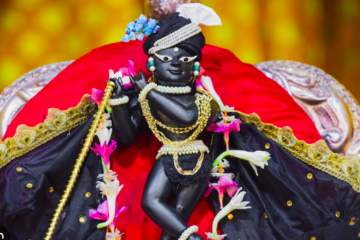
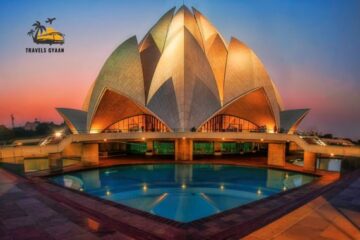

0 Comments